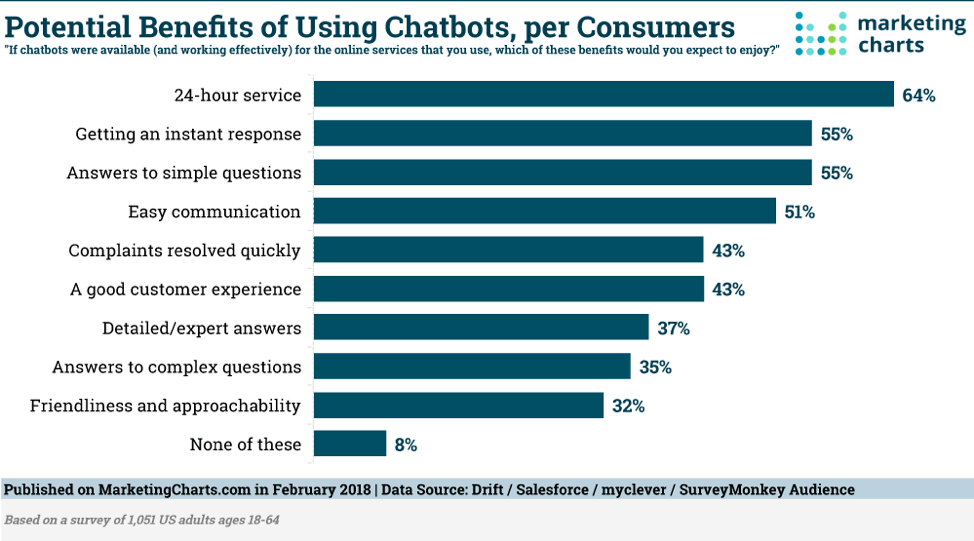Live chat is a valuable customer service tool, but you need to use it correctly. There is plenty you should do but also a number of things you need to avoid
Excellent customer service has two critical elements. The first is solving the customer query as soon as possible. The longer the case persists, then the more it becomes a nuance for your customer.
Secondly, you need to make the experience as smooth and enjoyable as possible. Even an acknowledgment of their issue, such as "I'll get back to you with a solution" can help with this. The solution can be provided later. People remember world-class customer service and they detest poor service.

Live chat can help fulfill both these elements. Kayako, a help desk software for customer service surveyed 100 customers to show the long-lasting impact of live chat on user experience:
- More than 50% of customers prefer to chat online with a person in real-time, instead of making a call for support.
- Website visitors who engage with a brand through live chat are worth 4.5 times more than visitors who don’t.
- 29% of consumers share a positive live chat experience with their friends and network.
- Almost 80% of businesses offering live chat had a positive influence on their sales, revenue and customer loyalty.
Shopping online is a lonely experience. At times, your products are delivered faster than your support emails get answered.
Live chat allows you to create a personal connection with the website visitors when they are looking for support. Added to this is the effectiveness of help that is fast and doesn’t interrupt their online buying experience.
You shouldn't miss the opportunity to strike up a conversation and offer help when the visitors are browsing or purchasing through your website, via live chat.
Here are the six dos and don’ts you should consider while adding live chat to your customer support arsenal.
The dos
“Empathy”
The majority of people rely on reviews when making a purchase, even a single negative review can affect your bottom line. Worse, it can result in negative reviews that can go viral. However, it's important to remember that bad reviews are not always a result of bad customer service and are sometimes beyond your control - even if you've done all you can to try and help a customer.
What you can control is the way your customer service team responds to such situations.
For example, if your user is upset by a defective/damaged product, you can apologize for the bad customer experience and send a free gift certificate while solving the problem. That gives you a chance to connect with the customer on a personal level, establish an authentic connection, and solve the query with a human approach.
Resolving a complaint is as effective as preventing it. Empathy not only improves your customer experience but can rescue your brand from a mishap.
Having a support staff deal with complicated customer inquiries or situations when customer emotions are running high is always a wise move. Customer satisfaction has a direct impact on brand loyalty which in return translates to sales.
Download our Free Resource – 10 common website customer experience mistakes
This guide reveals examples of poor website design from different sectors which are commonly seen, but best avoided.
Access the
Localize customer support
Your business can no longer afford to overlook multilingual customer support. A staggering 74% of customers prefer to purchase from a brand that offers post-sales support in their native language. Local support agents address the queries in the language your customers are comfortable with, to build a trusted brand.
Two major challenges you solve with multilingual customer service are the language and cultural context. For example, gender diversity is acceptable in some cultures while in many others, it is still not fully recognized.
Japanese customers can make out the difference in talking to a Japanese speaker from Singapore and Japan, and they prefer talking to the latter. Even within England, the Scottish accent is different from the Welsh accent and each prefers talking to their native representatives.
Language is a vital part of building a global customer-facing company.
Trigger messages to start a conversation on the pages where visitors require support
You can use live chat more proactively, to offer help when ta customer is browsing your website. Triggered messages use information such as geography and their behavior on the site (such as frequently visited pages and cart abandonment) to start a conversation.
The benefits of sending trigger messages are:
- Customized messages have a better conversion rate – According to a LiveChat report, visitors invited for a chat are three times more likely to convert as compared to those who don’t. When a visitor browses your website, the amount of content could be overwhelming, leading to confusion. When you start a chat with them, their doubts are instantly solved.
- Contextual chat leads to more sales – When you ask the visitor about the issue they’re facing in real-time, they’re more likely to share them. You can instantly respond, thereby closing a sale.
- Personalization helps to increase customer satisfaction – When you send customized greetings, the customers feel that you know them, making the experience pleasant for them.
The different types of trigger messages are:
- Welcome messages for first-time visitors
- Engaging with returning visitors
- Cart abandonment messages
- Help on the pricing page
- Starting a chat on the contact page
Live chat tools such as ProProfs, LiveChat Inc, Intercom and Drift can help you monitor visitor behavior and engage with people on your site.
Use a combination of canned responses and human agents
Artificial intelligence is becoming an integral part of customer support. A combination of chatbots and human agents solves queries quickly.
There are a number of different benefits of using chatbots as part of your customer care strategy. Customers appreciate the 24-hour service on offer, as well as being able to get an instant response and having their complaints resolved quickly.

Despite these applications, chatbots can be a double-edged sword. There have been instances when chatbots used without human intervention delivered responses that a brand probably wouldn't be happy with.
A famous example of chatbots gone wrong is Microsoft’s Tay. Tay was launched to interact with Twitter users to develop a unique personality using AI and natural language processing. Microsoft thought that the more Tay interacted with humans, the smarter it would get.
Unfortunately, within 24 hours, Tay became incredibly racist. The result being, Microsoft had to pull it down after a single day.
Some of Tay’s interactions were:


To prevent such mishaps, let your support agents take over when the bot fails to grasp the context. Canned responses from chatbots are quick and efficient for greetings, collecting general information, FAQs, pricing, offers, and policies.
However, you still need to give the customer an option to speak to the support agent for assistance. Technology isn’t that advanced that it can convey empathy and emotions the way a human can.

When a customer wants to know the sizes available in stock on your e-commerce store, the chatbot can reply. But when they want to know why a discount coupon was not applied, let the customer care team take over.
Zoho SalesIQ (also called Zobot) and FreshChat allow you to automate the first level conversations such as collecting information about your leads and giving them the option to chat with live representatives in the same chat window.
Better Proposals, an online proposal software, can be integrated with your live chat software to answer questions while the prospect is reading your proposal. When done right, this leads to increased engagement and boosts website conversions.
Here are the two mistakes you should avoid at all costs and their solutions:
Don’t keep them waiting
Research carried out by Forrester and Amex shows that 20% of Generation Z (people aged 16-22) will stop using a brand if their live chat responses were too slow. Based on the 2019 Customer Service Report by LiveChat, the average first response time on chat was 48 seconds. It’s three seconds faster than the year before. Companies should try to be above that average.
Time is of the essence in live chat, so why are so many businesses getting this wrong?
Either they’re claiming to be available when in fact they’re not, or they have too few agents to deal with the volume of requests.
Set up live chat only if you know that you have the resources to provide instant high-quality service. If not, consider offering email or telephone.
After all, the whole point of live chat is to ensure a quick conversation. Acknowledge their message quickly. If a customer must wait, then let them know for how long they will have to wait. Also, share the reason for the delay in response.
Don’t forget etiquette
Have you ever come across a rude live agent? If yes, did your conversation lead to a positive outcome? Surely your answer is "no". Rude live agents seldom add anything positive to the brand image and instead, compel the visitors to spread a not-so-happy experience with everyone else.
Besides, a good response has the following parts:
- Start the conversation with a greeting.
- Solving the query or letting the user know that the issue is being addressed.
- Sharing additional information in the form of blog posts or knowledge base content.
- Close the loop with a “hope you were satisfied with our answer”.
Be calm and composed and try to help the visitors in the best way possible. Ensure that they do not show signs of irritation or negativity when the conversation fails to go great.
Wrapping up
Live chat can be one of the most effective tools for a business to convert browsers into customers. Engage with visitors, resolve their queries and compel them to make a purchase from you in a matter of minutes, using live chat!
Priyanka Desai is the founder of
iScribblers, a content marketing agency for SaaS and technology companies. Her articles are published on SEMrush, Forbes India and Tech in Asia to name some.












